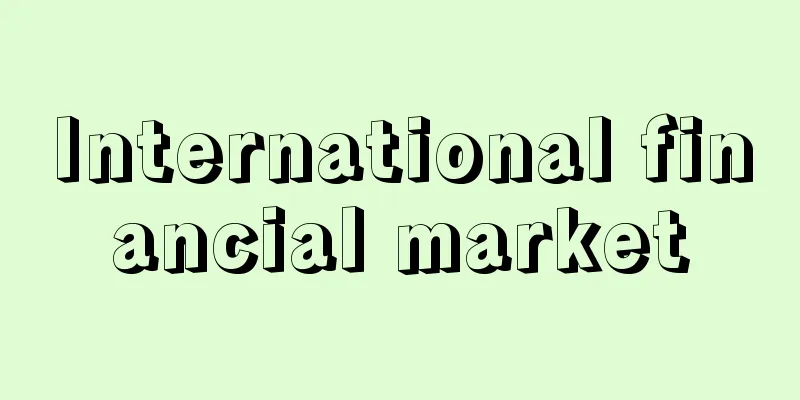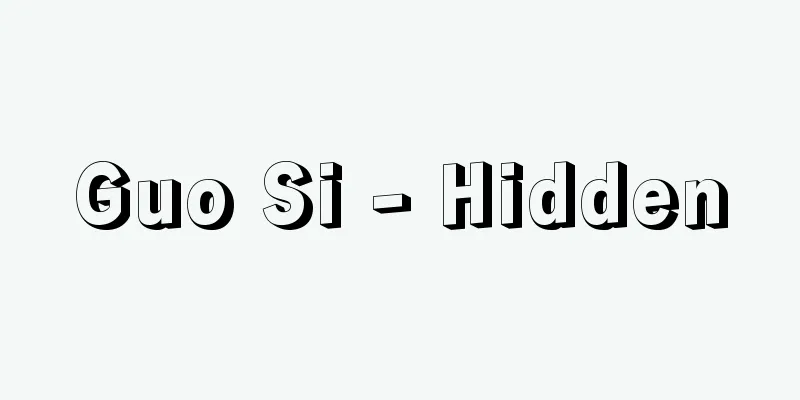International financial market

|
International finance is the process of financing excess or shortage of funds across borders, and the international financial market is the forum for this. Even within the domestic financial system, foreign currency-denominated financing such as foreign currency deposits and impact loans may be included in international financial transactions. Financial transactions are divided into long-term and short-term depending on the length of the financial period, and the short-term market is usually called the international financial market, while the long-term market is called the international capital market, focusing on the securities market. However, the distinction between the bank deposit market, which includes time deposits of one year or more and large, long-term syndicated loans (joint loans by multiple banks), and the lending market is ambiguous, and the term is not always used strictly. In many cases, the term international financial market is used to encompass all financial transactions, rather than international financial or capital markets. Historically, international trade settlements have generally been made in the key currency of the world economy at the time, and financing for trade is often also done in that currency. Furthermore, backed by their powerful economies and current account surpluses, these countries engage in global lending activities and, in turn, provide a venue for the management of the world's surplus funds. Therefore, the currencies of powerful countries have become international currencies, or key currencies, and the financial markets of these countries have become international financial markets. In other words, this is how international financial markets were formed in London when the pound was the key currency, and in New York after the US dollar replaced the pound. The conditions are: Therefore, today's international financial markets have two sides: a traditional market and a euro market. A traditional market is when international financial transactions are conducted in the currency of the country where the market is located, and a euro market is when international financial transactions are conducted in a currency other than the currency of the country where the market is located. The New York market has a strong function as a traditional market because the home currency is the key currency, while the London market has a strong euro market character because international financial transactions are conducted in euro currencies other than the pound, such as the euro dollar, the euro-euro (also called xenos, but neither of these names has been established), and the euro yen. However, other international financial markets also have a more or less dual nature. In addition to the traditional spot transactions such as deposits, loans, stocks, bonds, and foreign exchange, derivatives (financial derivative products) were added in the early 1970s, and the latter transaction amount had ballooned to 596 trillion dollars (based on notional principal) at the end of 2007. [Seiichi Nakajo] Euro and Offshore MarketsThe euro market is a market where financial transactions are conducted using funds that flow out of the issuing country and are deposited overseas. The origin of this was the late 1950s, when the Soviet Union, fearing the freezing of its deposits in the United States, transferred its dollar deposits to European banks. The euro dollar market was born in Europe, centered in London, and hence the name euro. Therefore, it is important to note that this has a different meaning from the common European currency, the euro. Unlike traditional markets, the euro market is less regulated by authorities and has preferential tax treatment, making it possible to conduct advantageous transactions in terms of both management and procurement. In the midst of this, the euro market has achieved remarkable development due to the progress of liberalization of exchange controls in various countries, the large inflow of oil dollars after the oil crisis, the formation of syndicated loans against the backdrop of this, the increase in euro bonds through subsequent securitization, and the emergence of new short- and medium-term facilities. Since the late 1960s, the market has expanded geographically not only to Europe but also to Hong Kong, Singapore, Bahrain, the Bahamas, etc., and the trading currencies have expanded to include the German mark, yen, pound, etc., and are collectively referred to as euro currencies. However, dollars in Asia are sometimes called Asian dollars rather than euro dollars. In order to enhance the function of the euro market, some international financial markets have established offshore markets that allow euro transactions only between non-residents. These transactions are called "foreign-foreign transactions" and, unlike domestic transactions, are less regulated and are also favored in terms of taxation. The offshore markets that are separated into domestic and foreign include the New York offshore market IBF (International Banking Facilities), established in 1981, the Tokyo offshore market JOM (Japan Offshore Market), established in 1986, and the Singapore offshore market ACU (Asian Currency Unit), and tax havens such as the Bahamas and the Cayman Islands are also offshore markets. London and Hong Kong are also integrated domestic and foreign markets, with no distinction between foreign-foreign transactions and domestic transactions. In other words, the offshore market can be said to be a special market within the euro market that conducts typical euro transaction operations. [Seiichi Nakajo] London Financial MarketBritain achieved the Industrial Revolution ahead of other countries in the early 19th century, and established its economic dominance in the world by promoting free trade. With these circumstances as a backdrop, London became the center of world trade and finance, and established its position as an international financial market. There were organizations of specialists skilled in international finance, such as discount houses, acceptance houses, and merchant banks, who accepted and discounted foreign exchange bills, promoted short-term international finance, and even engaged in securities underwriting, developing the securities market. However, after two world wars, the status of the pound gradually declined as the British economy weakened, and after World War II, it ceded its position to New York. However, London, which has traditionally played a role as an international financial market, began to revive with the appearance of the Eurodollar in the late 1950s. In other words, because British financial institutions had advanced technology in international finance and foreign exchange, and the government did not impose regulations on foreign currency transactions and was flexible in its response, dollars that flowed out of the United States to avoid interest rate regulations were deposited in the London financial market and lent out as dollars. This Eurodollar market expanded dramatically in the 1970s, partly due to the inflow of oil money, and at the same time, similar transactions also became active for currencies such as the West German mark (at the time), Swiss franc, and pound, and the London financial market was revived as the Eurocurrency market, including the dollar. Although the market size, including the domestic financial market, is not as large as New York's, it can be said to be the largest market in the world for international financial transactions with non-residents and between non-residents. [Seiichi Nakajo] New York Financial MarketAfter the Second World War, the United States was the only country that did not implement exchange control from the beginning, and in the midst of the devastation of Europe, the dollar became an international currency that surpassed the pound due to its absolute political and economic dominance. With its abundant dollar funds, New York became the market that best met the requirements of an international financial market. The New York financial market is the world's largest and most developed short-term financial market, with the Federal Funds market (corresponding to the call market in other countries), where banks borrow and lend their deposit balances at the Federal Reserve Bank, the Treasury Bills (TB) market with maturities of one year or less, the banker's acceptances market, the commercial bills market, and the negotiable certificates of deposits market. As the United States has become a net debtor nation, it has become a net investment market for non-residents rather than a fund raising market. In particular, many foreign monetary authorities manage their foreign exchange reserves in the relatively large Treasury Bills market, and many foreign banks participate in the Federal Funds market and the banker's acceptances market. The New York financial market is characterized by international financial transactions rooted in a huge domestic financial market, but in 1981 it established the IBF, a forum for international trading, in an effort to strengthen international financial transactions. [Seiichi Nakajo] Tokyo Financial MarketThe Tokyo financial market began to emerge in the mid-1980s. The basic background to this was the improvement of Japan's economic power, but also the country's growing current account surplus led to it becoming a capital exporting country (a creditor nation). Furthermore, the liberalization of exchange controls in 1980, the liberalization of the Tokyo financial capital market based on the 1984 Japan-U.S. Yen-Dollar Committee Report, and financial liberalization through the issuance of large amounts of government bonds all contributed to the rapid development of the market, and by the end of the 1980s, Tokyo had become one of the world's three major international financial centers, alongside New York and London. It was even said that Japan money took over the market, but after the collapse of the bubble economy and the slump of the so-called "lost decade," it is finally showing signs of recovery. The market is characterized by its underdeveloped and underperforming short-term financial market, centered on TBs and FBs (Financing Bills).The market functions to a certain extent as a traditional market, with yen-denominated investments by foreign investors, primarily in the stock market, samurai bond issues, yen-denominated syndicated loans, and even euro-yen transactions in the JOM, but it mainly functions as a euro market based on foreign currency acquired through external trade transactions and foreign currency procured from euro markets such as London. [Seiichi Nakajo] "International Financial Markets" edited by Ichiro Takeuchi and Nobuyuki Hara (1988, Yuhikaku) " ▽ "An Introduction to International Finance by Nobuyuki Hara (1992, Yuhikaku)" ▽ "Seminar: Introduction to International Finance by Miyako Suda (1996, Nihon Keizai Shimbun)" ▽ "Modern International Finance" edited by Takao Kamikawa, Seiichi Fujita, and Hisakazu Mukai, 3rd edition (2007, Yuhikaku)" [References] | |Source: Shogakukan Encyclopedia Nipponica About Encyclopedia Nipponica Information | Legend |
|
国境を越えて資金の過不足を融通するのが国際金融であり、その場となるのが国際金融市場である。国内の金融でも、外貨預金やインパクト・ローンのような外貨建てでの金融は、国際金融取引に含まれる場合がある。金融期間の長さにより長期と短期に分けられ、通例では短期市場を国際金融市場といい、証券市場を中心に、長期市場を国際資本市場とよんで区別している。しかし、1年以上の定期預金や大型で長期のシンジケート・ローン(複数の銀行団による協調融資)などを含む銀行預金市場や貸付市場の区分が曖昧(あいまい)であり、必ずしも厳格な使用がなされているわけではない。国際金融・資本市場とせずに、国際金融市場という用語で、すべての金融取引を包摂する場合も少なくない。 歴史的にみると、国際貿易の決済は、そのときどきの世界経済の基軸通貨建てで行われるのが一般的であり、貿易に伴うファイナンスもその通貨でなされることが多い。さらに、そうした国は、強大な経済力、経常収支の黒字を背景に、世界的な融資活動を行い、逆に、世界の余剰資金の運用の場を提供する。したがって、強大国通貨が国際通貨、基軸通貨となり、その国の金融市場が国際金融市場となってきた。つまり、基軸通貨がポンドであった時代のロンドン、米ドルがポンドにとってかわった後のニューヨークでは、このようにして国際金融市場が形成されたわけである。 その条件は、 したがって、今日の国際金融市場は、伝統的市場とユーロ市場としての機能の二面性をもつ。伝統的市場とは、その市場がある国の通貨建てで国際金融業務が行われる場合であり、ユーロ市場とは、その市場がある国の通貨以外の通貨建てで国際金融業務が行われる場合である。ニューヨーク市場は、自国通貨が基軸通貨であるため、伝統的市場としての機能が強く、ロンドン市場はポンド以外のユーロ・ダラー、ユーロ・ユーロ(ゼノスともよばれるが、いずれも定着した呼称ではない)、ユーロ円といったユーロ・カレンシーでの国際金融業務が多く、ユーロ市場としての色彩が強いが、ほかの国際金融市場もあわせて多かれ少なかれ二面性がみられる。また、そこでの金融取引も、従前からの預金、貸付、株式、債券、外国為替といった現物取引だけでなく、1970年代初頭からデリバティブ(金融派生商品)が加わり、後者の取引額は2007年末には596兆ドル(想定元本ベース)に水ぶくれしている。 [中條誠一] ユーロ市場とオフショア市場その通貨の発行国から海外に流出し、預金された資金によって、金融業務がなされる市場をユーロ市場という。1950年代後半に、アメリカの預金凍結を恐れたソ連が、ドル預金をヨーロッパの銀行に移管したことを嚆矢(こうし)とし、ユーロ・ダラー市場としてロンドンを中心にヨーロッパで誕生したことからユーロの名が付けられた。したがって、ヨーロッパの共通通貨「ユーロ」とは異なる意味であり、注意を要する。 ユーロ市場は、伝統的市場とは異なり、当局の規制が少なく、税制面でも優遇されているため、運用面でも、調達面でも有利な取引が可能である。そのなかで、各国での為替管理の自由化の進捗、石油ショック後のオイル・ダラーの大量流入、それを背景としたシンジケート・ローンの組成、その後の証券化によるユーロ債の増大、短中期の新規ファシリティの登場などにより、めざましい発展をとげてきた。1960年代後半から市場は、ヨーロッパだけでなく、香港、シンガポール、バーレーン、バハマ等へと地理的広がりをみせるとともに、取引通貨もドイツ・マルク、円、ポンドなどにも広がり、ユーロ・カレンシーと総称されている。ただし、アジアにあるドルのことを、ユーロ・ダラーではなく、アジア・ダラーとよぶこともある。 各国の国際金融市場のなかには、ユーロ市場としての機能を高めるために、ユーロ取引を非居住者同士でのみ認めるオフショア市場を創設しているところがある。この取引は、「外‐外取引」とよばれ、国内取引と違い規制が少なく、税制面でも優遇されている。内外分離型といわれるもので、1981年創設のニューヨークオフショア市場IBF(International Banking Facilities)、1986年創設の東京オフショア市場JOM(Japan Offshore Market)、シンガポールオフショア市場ACU(Asian Currency Unit)などがあるが、さらにバハマ、ケイマンなどのタックス・ヘイブンもオフショア市場である。また、ロンドンや香港は、外‐外取引と国内取引の区分のない内外一体型となっている。つまり、オフショア市場は、ユーロ市場のなかでも典型的なユーロ取引業務を行う特殊な市場といいうる。 [中條誠一] ロンドン金融市場イギリスは19世紀初めに他国に先駆けて産業革命を成し遂げ、自由貿易主義を掲げて世界における経済的優位を確立した。ロンドンはこうした事情を背景に、世界貿易・金融の中心となり、国際金融市場の地位を確立した。そこには割引商会(ディスカウント・ハウス)、引受商会(アクセプタンス・ハウス)、商業銀行(マーチャント・バンク)など国際金融に熟練した専門業者の組織があって、外国為替手形の引受けや割引を行い、短期国際金融を促進し、さらには証券引受け業務を行い、証券市場も発達していた。しかし二度にわたる大戦を経て、イギリス経済の地盤低下とともにポンドの地位もしだいに低下し、第二次世界大戦後はニューヨークにその地位を譲ることとなった。 しかしながら、国際金融市場の伝統的機能をもつロンドンは、1950年代末のユーロ・ダラーの登場で復活し始めた。すなわち、イギリスの金融機関が国際金融や外国為替に関する高度な技術を有していたこと、政府が外貨取引に関し規制を課さず、柔軟な対応をしたことによって、金利規制などを嫌ってアメリカから流出したドルがロンドン金融市場へ預けられ、ドルのまま貸し出された。このユーロ・ダラー市場は1970年代にはオイル・マネーの流入もあって飛躍的に拡大したが、それとともに西ドイツ・マルク(当時)、スイス・フラン、ポンドなどの通貨についても同じような取引が盛んになり、ドルを含めたユーロ・カレンシー市場として、ロンドン金融市場は蘇った。国内金融市場も含めた市場規模は、ニューヨークには及ばないものの、対非居住者および非居住者同士の国際金融取引では、世界最大の市場といえる。 [中條誠一] ニューヨーク金融市場第二次世界大戦後、アメリカは当初から為替管理を実施しなかった唯一の国であり、またヨーロッパの荒廃のなかで、政治・経済上の絶対優位を得たことにより、ドルはポンドをしのぐ国際通貨となり、豊富なドル資金を有するニューヨークは、国際金融市場の要件をもっとも備えた市場となった。ニューヨーク金融市場は、連邦準備銀行への預金残高を銀行間で貸し借りするフェデラル・ファンド市場(諸外国のコール市場に該当)、期限1年以内の財務省証券(TB)市場、銀行引受手形市場、商業手形市場、譲渡性定期預金証書市場など、短期金融市場のもっとも発達した世界最大の市場規模を誇る市場である。アメリカが純債務国に陥ったこともあり、非居住者にとって、ネットでは資金調達より、運用市場となっている。とくに、相対的に大きな財務省証券市場では多くの諸外国通貨当局がその外貨準備を運用しており、またフェデラル・ファンド市場、銀行引受手形市場には、外国銀行が多数参加している。 巨大な国内金融市場に根ざした国際金融取引というところに、ニューヨーク金融市場の特徴があるが、1981年には外‐外取引の場であるIBFを創設し、国際金融取引の強化を図っている。 [中條誠一] 東京金融市場東京金融市場は、1980年代半ばに台頭をみた。その基本的背景には、日本の経済力の向上があるが、拡大する経常収支黒字による資本輸出国化(債権国化)があった。さらに、1980年(昭和55)の為替管理の自由化、1984年の日米円ドル委員会報告に基づく、東京金融資本市場の自由化、国債の大量発行による金融の自由化等が追い風になって、急速な発展をとげ、1980年代末にはニューヨーク、ロンドンと並ぶ世界三大国際金融センターに躍り出た。ジャパン・マネーの席捲(せっけん)とさえいわれたが、バブル経済崩壊後、いわゆる「失われた10年」の低迷を経て、ようやく復活の兆しをみせている。 その市場の特徴は、TB、FB(Financing Bills)を中心に短期金融市場が未発達で、見劣りする点である。市場の機能としては、株式市場を中心とした海外投資家の円建て運用、サムライ債の発行、円建てシンジケート・ローン、さらにはJOMでのユーロ円取引といったように、伝統的市場としての役割も一定程度担っているが、主体は対外貿易取引による獲得外貨、ロンドン等のユーロ市場からの調達外貨をベースとしたユーロ市場としての機能であるといえる。 [中條誠一] 『竹内一郎・原信編『国際金融市場』(1988・有斐閣)』▽『原信著『国際金融概論』(1992・有斐閣)』▽『須田美矢子著『ゼミナール国際金融入門』(1996・日本経済新聞社)』▽『上川孝夫・藤田誠一・向壽一編『現代国際金融論』第3版(2007・有斐閣)』 [参照項目] | |出典 小学館 日本大百科全書(ニッポニカ)日本大百科全書(ニッポニカ)について 情報 | 凡例 |
<<: International Airport - International Airport (English)
>>: International Financial Cooperation
Recommend
Sazaedo - Sazaedo
〘 noun 〙 A hall whose internal staircase is struct...
The Jingxiang Rebellion
A peasant rebellion that took place in the mountai...
White Bride and Black Bride - Shiroi Yome to Kuroi Yome
This is the title given to number 135 in Grimm'...
Fescue - Fescue
→ Fescue Source : Heibonsha Encyclopedia About MyP...
Calcium soap based grease - Calcium soap based grease
…Here are some examples. (1) Calcium soap-based g...
Strip survey method - Strip survey method
...The total number is estimated by expanding the...
Latvian - Ratobiyago (English spelling)
It is the national language of the Republic of La...
Upper Rhine Graben - Upper Rhine Graben
…Here, the structure is systematic, as indicated ...
Exclusive patent
〘 noun 〙① An official license for the right to mon...
pulu
…Japanese dakyu (ball) is also from the same fami...
Okubo Hikozaemon
Born in 1560 in Odawara [Died] Kan'ei 16 (1639...
Macrodorcas rectus (English spelling)
…Adults are raised on apples and other foods, and...
Basil Henry Liddell Hart
1895‐1970 British military commentator. Served in ...
External bureau - Gaikyoku
An administrative agency that reports directly to ...
Gagaku Shakuhachi
...During lessons, students learn by pronouncing ...









